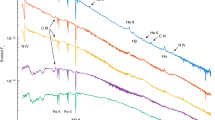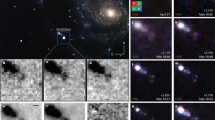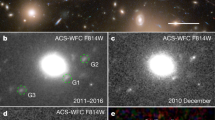Abstract
ON 28 March 1993, a new supernova was discovered1 in the nearby galaxy M81. The proximity of the event (the distance2 to M81 is only 3.6 Mpc), and the fact that the supernova was detected at an early stage of its outburst3, makes SN1993J an ideal candidate for the detailed study of the evolution of a supernova in all wavelength regimes. We report here the detection of soft X-ray emissions from SN1993J, six days after the initial discovery, and the subsequent evolution of the X-ray light curve over the next 41 days. The spectral characteristics of the emissions can be readily explained if the X-rays originate in strong shock fronts produced by the rapid expansion of the supernova ejecta into the slow, dense wind of a red supergiant progenitor star4. The low intrinsic absorption of the earliest emissions requires that any circumstellar material is ionized, probably by the intense radiation of the initial outburst. The decay of the X-ray luminosity with time should provide important constraints on the density profiles of both the circumstellar gas and the outermost layers of the supernova ejecta.
This is a preview of subscription content, access via your institution
Access options
Subscribe to this journal
Receive 51 print issues and online access
$199.00 per year
only $3.90 per issue
Buy this article
- Purchase on SpringerLink
- Instant access to full article PDF
Prices may be subject to local taxes which are calculated during checkout
Similar content being viewed by others
References
Ripero, J. IAU Circ. No. 5731 (1993).
Madore, B. F., Freedman, W. L. & Lee, M. G. IPAC Preprint No. 105 (1993).
Filippenko, A. V. & Matheson, T. IAU Circ. No. 5740 (1993).
Chevalier, R. A. Astrophys. J. 258 790–797 (1982).
Fabbiano, G. Astrophys. J. 325, 544–562 (1988).
Zimmermann, H.-U. et al. IAU Circ. No. 5748 (1993); IAU Circ. No. 5750 (1993); IAU Circ. No. 5766 (1993).
Tanaka, Y. and the ASCA team IAU Circ. No. 5753 (1993).
Hartwick, F. D. A., Balam, D. D., Zurek, D. & Robb, R. M. IAU Circ. No. 5731 (1993).
Dickey, J. M. & Lockman, F. J. A. Rev. Astr. Astrophys. 28, 215–261 (1990).
Suzuki, T. et al. Astrophys. J. (submitted).
Canizares, C. R., Kriss, G. A. & Feigelson, E. D. Astrophys. J. 253, L17–L21 (1982).
Itoh, M., Kumagai, S., Shigeyama, T., Nomoto, K. & Nishimura, J. Nature 330, 233–235 (1987).
Aschenbach, B. et al. Nature 330, 232–233 (1987).
Klein, R. I. & Chevalier, R. A. Astrophys. J. 223, L109–L112 (1978).
Zimmermann, H.-U. et al. IAU Circ. No. 5899 (1993).
Author information
Authors and Affiliations
Rights and permissions
About this article
Cite this article
Zimmermann, HU., Lewin, W., Predehl, P. et al. Detection of soft X-rays from supernova 1993J six days after outburst. Nature 367, 621–623 (1994). https://doi.org/10.1038/367621a0
Received:
Accepted:
Issue date:
DOI: https://doi.org/10.1038/367621a0



